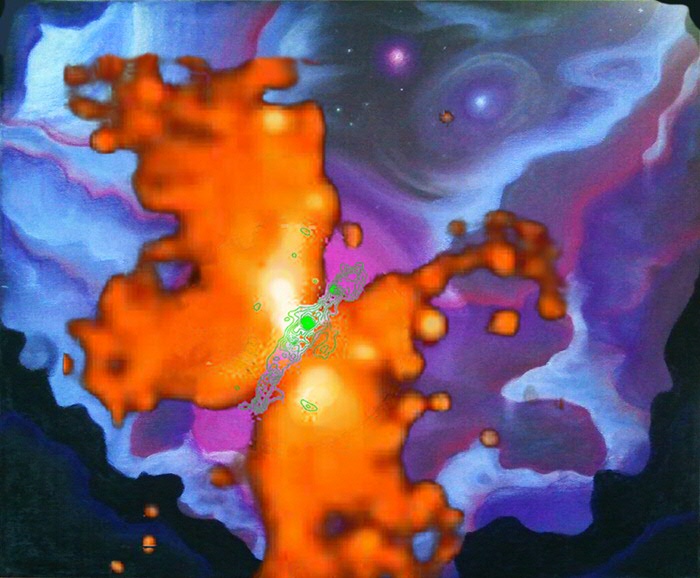
This artistic impression shows the universe around the star formation area with, as an overlay, the scientists’ observations.(c) Veronica Allen/Alexandra Elconin (http://alsewhere.weebly.com)
An international team of astronomers, led by Dutch scientists, has discovered a region in our Milky Way that contains many nitrogen compounds in the southeast of a butterfly-shaped star formation disk and very little in the north-west. The astronomers suspect that multiple stars-to-be share the same star formation disk, but the precise process is still a puzzle.
They studied the star forming region G35.20-0.74N, more than 7000 light years from Earth in the southern sky. The astronomers used the (sub)millimeter telescope ALMA which can map molecular gas clouds in which stars form. The researchers saw something special in the disk around a young, heavy star. While large amounts of oxygen-containing and sulfur-containing hydrocarbons were present throughout the disk, they found only N-containing molecules in the southeastern part of the disk. In addition, it was 150 degrees warmer on the nitrogen side than on the other side of the disk.
Based on these observations, the scientists suspect that there are multiple stars forming at the same time in one disk and that some stars are hotter or heavier than others. The researchers expect the disk to eventually break into several smaller disks as the stars grow.
A few years ago, there have been observed chemical differences in a star forming region in Orion. First author Veronica Allen (University of Groningen and SRON): “The area in Orion is five times bigger than our area. We have probably been lucky because we expect that such a chemical difference to be short-lived.” Floris van der Tak (University of Groningen and SRON): “Many of the nitrogen molecules are poisonous cyanides. We do not know much about them because it is dangerous to work with those molecules in laboratories on earth.”
The astronomers are now investigating the star formation cloud in more detail. Allen: “Maybe we can see the disk break into smaller disks in real time.” In addition, the astronomers make models to see how differences in age, mass, temperature or gas density can cause a difference in chemical composition, too.
http://www.rug.nl/news/2017/06/astronomers-see-mysterious-nitrogen-area-in-a-butterfly-shaped-star-formation-disk https://phys.org/news/2017-06-astronomers-mysterious-nitrogen-area-butterfly-shaped.htmljCp







Recent Comments